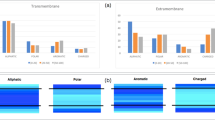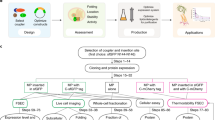Abstract
Multipass membrane proteins perform critical signal transduction and transport across membranes. How transmembrane helix (TMH) sequences encode the topology and conformational flexibility regulating these functions remains poorly understood. Here we describe a comprehensive analysis of the sequence-structure relationships at multiple interacting TMHs from all membrane proteins with structures in the Protein Data Bank (PDB). We found that membrane proteins can be deconstructed in interacting TMH trimer units, which mostly fold into six distinct structural classes of topologies and conformations. Each class is enriched in recurrent sequence motifs from functionally unrelated proteins, revealing unforeseen consensus and evolutionary conserved networks of stabilizing interhelical contacts. Interacting TMHs' topology and local protein conformational flexibility were remarkably well predicted in a blinded fashion from the identified binding-hotspot motifs. Our results reveal universal sequence-structure principles governing the complex anatomy and plasticity of multipass membrane proteins that may guide de novo structure prediction, design, and studies of folding and dynamics.
This is a preview of subscription content, access via your institution
Access options
Subscribe to this journal
Receive 12 print issues and online access
$259.00 per year
only $21.58 per issue
Buy this article
- Purchase on Springer Link
- Instant access to full article PDF
Prices may be subject to local taxes which are calculated during checkout





Similar content being viewed by others
References
von Heijne, G. Membrane-protein topology. Nat. Rev. Mol. Cell Biol. 7, 909–918 (2006).
Matthews, E.E., Zoonens, M. & Engelman, D.M. Dynamic helix interactions in transmembrane signaling. Cell 127, 447–450 (2006).
Krishnamurthy, H., Piscitelli, C.L. & Gouaux, E. Unlocking the molecular secrets of sodium-coupled transporters. Nature 459, 347–355 (2009).
Rakoczy, E.P., Kiel, C., McKeone, R., Stricher, F. & Serrano, L. Analysis of disease-linked rhodopsin mutations based on structure, function, and protein stability calculations. J. Mol. Biol. 405, 584–606 (2011).
Partridge, A.W., Therien, A.G. & Deber, C.M. Missense mutations in transmembrane domains of proteins: phenotypic propensity of polar residues for human disease. Proteins 54, 648–656 (2004).
Cymer, F., von Heijne, G. & White, S.H. Mechanisms of integral membrane protein insertion and folding. J. Mol. Biol. 427, 999–1022 (2015).
Petukhov, M., Muñoz, V., Yumoto, N., Yoshikawa, S. & Serrano, L. Position dependence of non-polar amino acid intrinsic helical propensities. J. Mol. Biol. 278, 279–289 (1998).
Minor, D.L. Jr. & Kim, P.S. Measurement of the beta-sheet-forming propensities of amino acids. Nature 367, 660–663 (1994).
Bystroff, C. & Baker, D. Prediction of local structure in proteins using a library of sequence-structure motifs. J. Mol. Biol. 281, 565–577 (1998).
Wolf, E., Kim, P.S. & Berger, B. MultiCoil: a program for predicting two- and three-stranded coiled coils. Protein Sci. 6, 1179–1189 (1997).
Zheng, F., Zhang, J. & Grigoryan, G. Tertiary structural propensities reveal fundamental sequence/structure relationships. Structure 23, 961–971 (2015).
Koga, N. et al. Principles for designing ideal protein structures. Nature 491, 222–227 (2012).
King, N.P. et al. Accurate design of co-assembling multi-component protein nanomaterials. Nature 510, 103–108 (2014).
Bill, R.M. et al. Overcoming barriers to membrane protein structure determination. Nat. Biotechnol. 29, 335–340 (2011).
Liu, Y., Engelman, D.M. & Gerstein, M. Genomic analysis of membrane protein families: abundance and conserved motifs. Genome Biol. 3, h0054 (2002).
Zhang, S.Q. et al. The membrane- and soluble-protein helix-helix interactome: similar geometry via different interactions. Structure 23, 527–541 (2015).
Mueller, B.K., Subramaniam, S. & Senes, A. A frequent, GxxxG-mediated, transmembrane association motif is optimized for the formation of interhelical Cα-H hydrogen bonds. Proc. Natl. Acad. Sci. USA 111, E888–E895 (2014).
Langosch, D. & Arkin, I.T. Interaction and conformational dynamics of membrane-spanning protein helices. Protein Sci. 18, 1343–1358 (2009).
Schneider, D. Rendezvous in a membrane: close packing, hydrogen bonding, and the formation of transmembrane helix oligomers. FEBS Lett. 577, 5–8 (2004).
Senes, A., Gerstein, M. & Engelman, D.M. Statistical analysis of amino acid patterns in transmembrane helices: the GxxxG motif occurs frequently and in association with beta-branched residues at neighboring positions. J. Mol. Biol. 296, 921–936 (2000).
Walters, R.F. & DeGrado, W.F. Helix-packing motifs in membrane proteins. Proc. Natl. Acad. Sci. USA 103, 13658–13663 (2006).
Nugent, T. & Jones, D.T. Accurate de novo structure prediction of large transmembrane protein domains using fragment-assembly and correlated mutation analysis. Proc. Natl. Acad. Sci. USA 109, E1540–E1547 (2012).
Hopf, T.A. et al. Three-dimensional structures of membrane proteins from genomic sequencing. Cell 149, 1607–1621 (2012).
Marks, D.S., Hopf, T.A. & Sander, C. Protein structure prediction from sequence variation. Nat. Biotechnol. 30, 1072–1080 (2012).
Sarkar, C.A. et al. Directed evolution of a G protein-coupled receptor for expression, stability, and binding selectivity. Proc. Natl. Acad. Sci. USA 105, 14808–14813 (2008).
Cammett, T.J. et al. Construction and genetic selection of small transmembrane proteins that activate the human erythropoietin receptor. Proc. Natl. Acad. Sci. USA 107, 3447–3452 (2010).
Gurezka, R. & Langosch, D. In vitro selection of membrane-spanning leucine zipper protein-protein interaction motifs using POSSYCCAT. J. Biol. Chem. 276, 45580–45587 (2001).
Bowie, J.U. Helix packing in membrane proteins. J. Mol. Biol. 272, 780–789 (1997).
Wang, Y. & Barth, P. Evolutionary-guided de novo structure prediction of self-associated transmembrane helical proteins with near-atomic accuracy. Nat. Commun. 6, 7196 (2015).
Cortes, C. & Vapnik, V. Support-vector networks. Mach. Learn. 20, 273–297 (1995).
Chang, C.-C. & Lin, C.-J. LIBSVM: a library for support vector machines. ACM Trans. Intell. Syst. Technol. 2, 1–27 (2011).
Barth, P., Schonbrun, J. & Baker, D. Toward high-resolution prediction and design of transmembrane helical protein structures. Proc. Natl. Acad. Sci. USA 104, 15682–15687 (2007).
Chen, K.Y., Zhou, F., Fryszczyn, B.G. & Barth, P. Naturally evolved G protein-coupled receptors adopt metastable conformations. Proc. Natl. Acad. Sci. USA 109, 13284–13289 (2012).
Barth, P., Wallner, B. & Baker, D. Prediction of membrane protein structures with complex topologies using limited constraints. Proc. Natl. Acad. Sci. USA 106, 1409–1414 (2009).
Joh, N.H. et al. De novo design of a transmembrane Zn2-transporting four-helix bundle. Science 346, 1520–1524 (2014).
Dror, R.O. et al. Activation mechanism of the β2-adrenergic receptor. Proc. Natl. Acad. Sci. USA 108, 18684–18689 (2011).
Jayasinghe, S., Hristova, K. & White, S.H. MPtopo: a database of membrane protein topology. Protein Sci. 10, 455–458 (2001).
Kozma, D., Simon, I. & Tusnády, G.E. PDBTM: Protein Data Bank of transmembrane proteins after 8 years. Nucleic Acids Res. 41, D524–D529 (2013).
Andreani, J., Faure, G. & Guerois, R. Versatility and invariance in the evolution of homologous heteromeric interfaces. PLoS Comput. Biol. 8, e1002677 (2012).
Zhu, H., Sommer, I., Lengauer, T. & Domingues, F.S. Alignment of non-covalent interactions at protein-protein interfaces. PLoS One 3, e1926 (2008).
Tibshirani, R., Walther, G. & Hastie, T. Estimating the number of data clusters via the Gap statistic. J. Roy. Stat. Soc. B 63, 411–423 (2001).
Chen, V.B. et al. MolProbity: all-atom structure validation for macromolecular crystallography. Acta Crystallogr. D Biol. Crystallogr. 66, 12–21 (2010).
Acknowledgements
We thank the members of the Barth laboratory for insightful discussions during this study and critical comments on the manuscript. This work was supported by a grant from the US National Institute of Health (1R01GM097207-01A1) and by a supercomputer allocation from XSEDE (Extreme Science and Engineering Discovery Environment; MCB120101) to P.B.
Author information
Authors and Affiliations
Contributions
P.B. designed the study; X.F. performed the study; P.B. and X.F. analyzed and discussed the results; P.B. wrote the manuscript.
Corresponding author
Ethics declarations
Competing interests
The authors declare no competing financial interests.
Supplementary information
Supplementary Text and Figures
Supplementary Results, Supplementary Figures 1–5 and Supplementary Tables 1–6. (PDF 6180 kb)
Rights and permissions
About this article
Cite this article
Feng, X., Barth, P. A topological and conformational stability alphabet for multipass membrane proteins. Nat Chem Biol 12, 167–173 (2016). https://doi.org/10.1038/nchembio.2001
Received:
Accepted:
Published:
Issue Date:
DOI: https://doi.org/10.1038/nchembio.2001
This article is cited by
-
ABC-transporter CFTR folds with high fidelity through a modular, stepwise pathway
Cellular and Molecular Life Sciences (2023)
-
Small-residue packing motifs modulate the structure and function of a minimal de novo membrane protein
Scientific Reports (2020)
-
Toward high-resolution computational design of the structure and function of helical membrane proteins
Nature Structural & Molecular Biology (2016)



